Cpl. Dustin Rollins, a combat tracker with Military Working Dog Platoon, 2nd Law Enforcement Battalion, II Marine Expeditionary Force Headquarters Group, gives his dog Nicky a drink from his canteen aboard Marine Corps Base Camp Lejeune, N.C., Oct. 9, 2014. The dog had successfully tracked the scent of a Marine during tracker and patrol training. Rollins is from Richmond, Ky. (Lucas J. Hopkin/U.S. Marine Corps)
Cpl. Dustin Rollins, a combat tracker with Military Working Dog Platoon, 2nd Law Enforcement Battalion, II Marine Expeditionary Force Headquarters Group, gives his dog Nicky a drink from his canteen aboard Marine Corps Base Camp Lejeune, N.C., Oct. 9, 2014. The dog had successfully tracked the scent of a Marine during tracker and patrol training. Rollins is from Richmond, Ky. (Lucas J. Hopkin/U.S. Marine Corps)
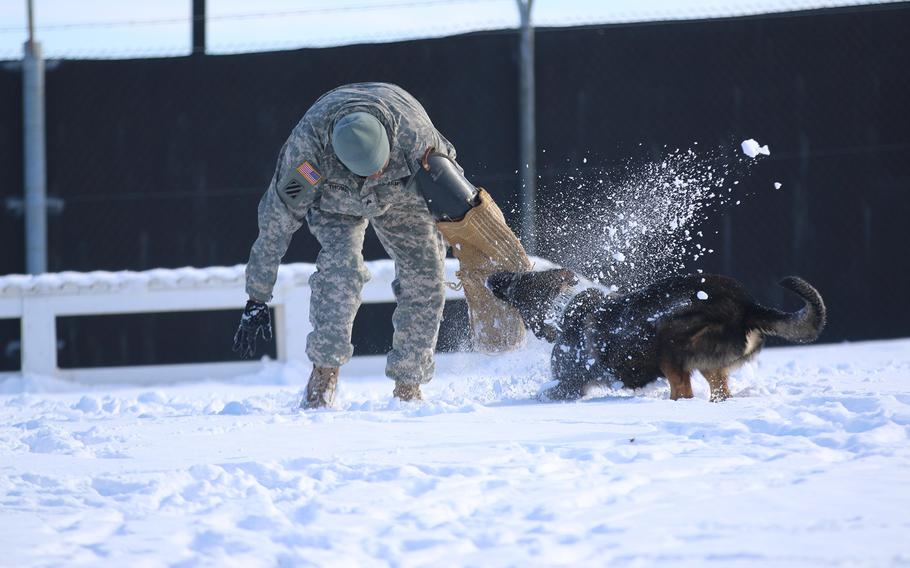
Sgt. Earl Thomas, a military working dog handler with the 525th Military Police Detachment out of Wiesbaden, Germany, plays the decoy as Spc. Hundi, a an explosive detection working dog, bites down on the wrap during bite training at Camp Bondsteel, Kosovo, Jan. 15, 2015. (Melissa Parrish/U.S. Army)
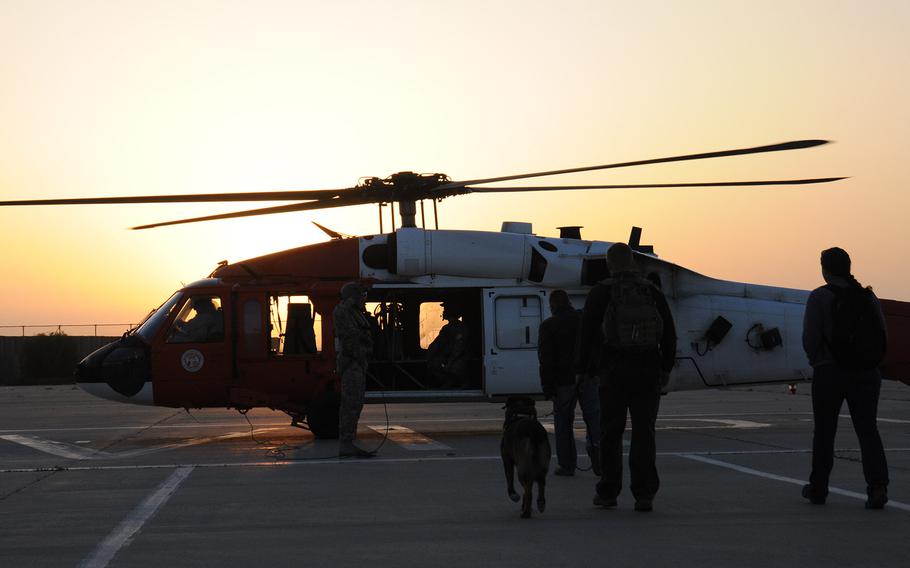
Dano, a military working dog, and his handler Staff Sgt. John Breyer (center foreground), along with several MFO Peacekeeper support staff prepare to board a Multinational Force and Observer's UH-60 Blackhawk as the sun sets over MFO's North Camp in El Gorah, Egypt, April 26, 2015. Dano was medically evacuated to Tel Aviv, Israel for a dental procedure. He returned to North Camp the same day with a clean bill of health. (Jennifer Dyrcz/U.S. Army)
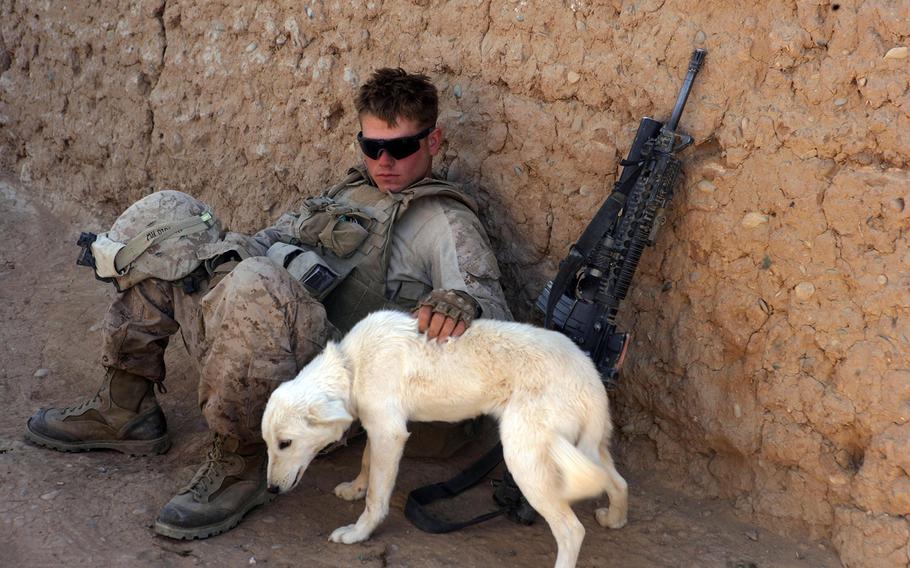
A U.S. Marine with Golf Company, 2nd Battalion, 6th Marine Regiment, Regimental Combat Team 1 pets a dog in a compound during a clearing operation in southern Marjah, Afghanistan, Dec. 2, 2010. The Marines searched for enemy activity and interacted with Afghan citizens. The regiment was deployed to Helmand province to support the International Security Assistance Force. (Shawn P. Coover/U.S. Marines)
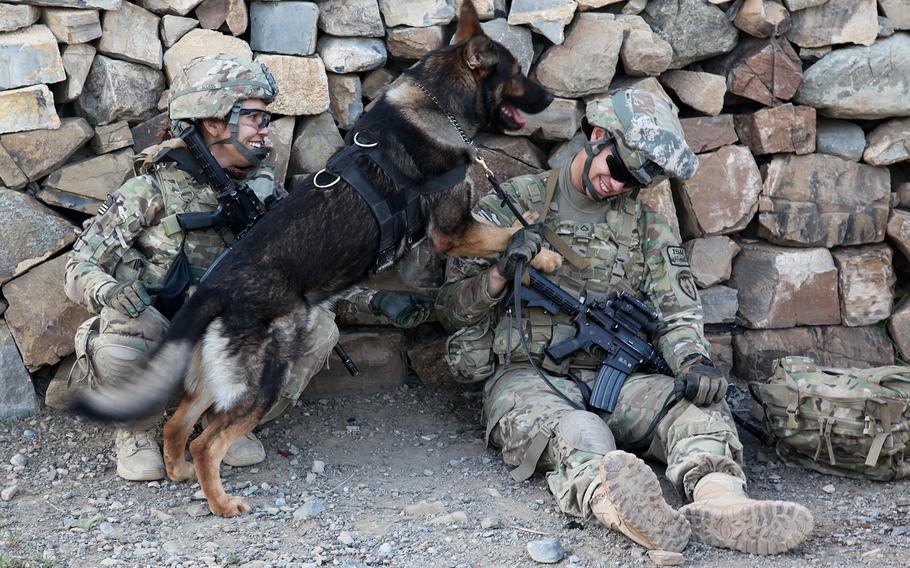
U.S. Army Pfc. Chris Kunze, a cannon crewmember assigned to A Battery, 2nd Battalion, 377th Parachute Field Artillery Regiment, Task Force 4-25, relaxes with his military working dog in Khoni Ghar May 27, 2012. (Kimberly Trumbull/U.S. Army)
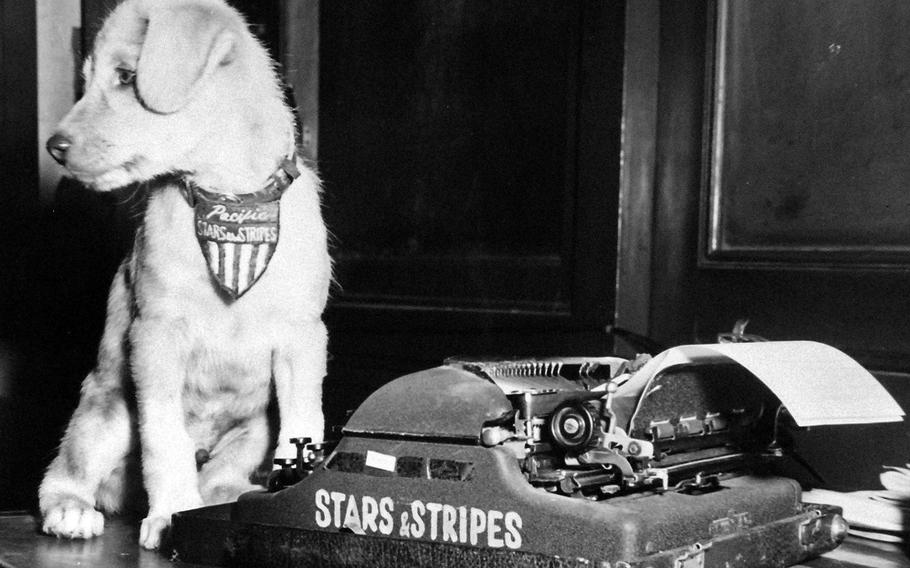
"Scoop", mascot dog of the Korea Bureau of Stars and Stripes personnel posed at his typewriter on Sept. 28, 1950. (U.S. Naval Institute)
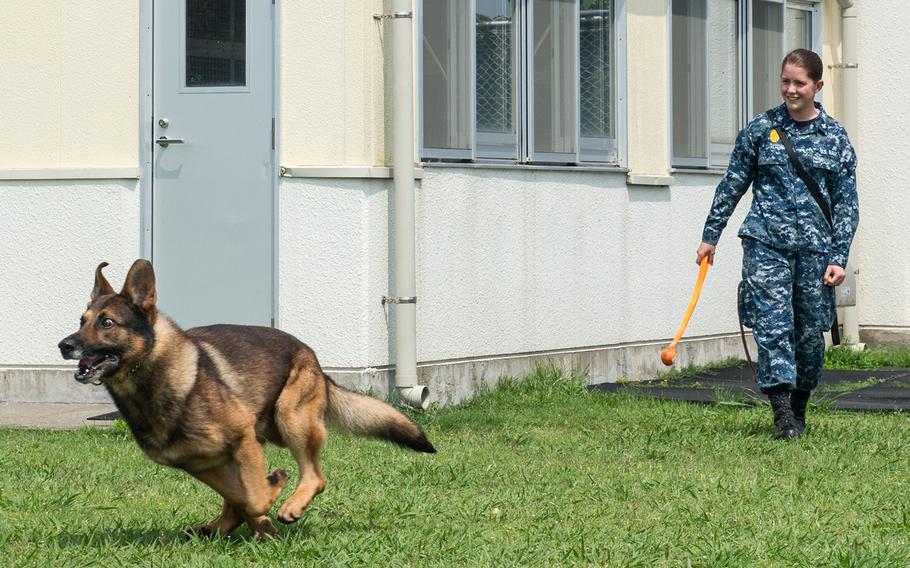
Master-at-Arms 3rd Class Kelsey Carlton, from Clearwater, Fla., assigned to Military Working Dog unit at Fleet Activities Yokosuka, conducts obstacle course training with military working dog Donci. The canines with the unit are used to apprehend suspects, detect explosives and narcotics while searching buildings, ships and submarines. (Christian Senyk/U.S. Navy)
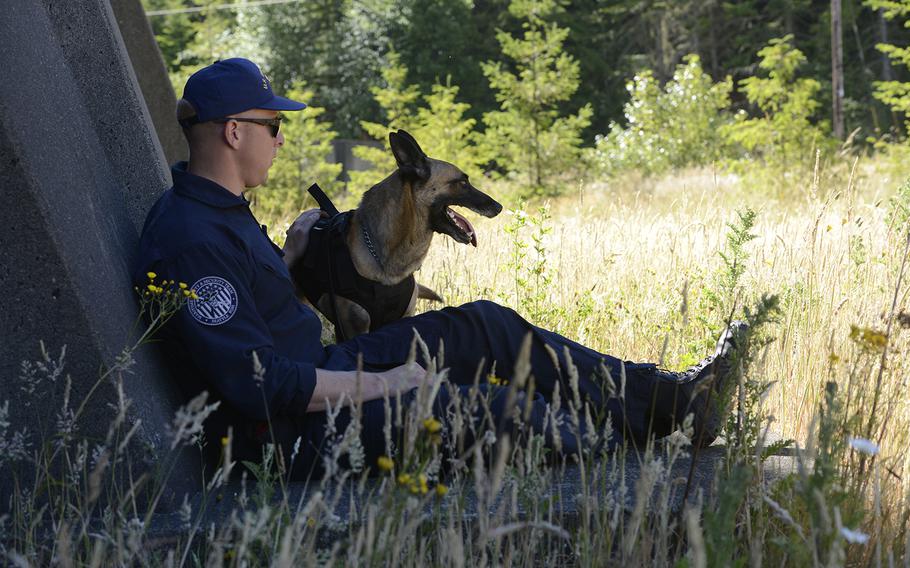
Petty Officer 2nd Class James Grant, maritime enforcement specialist and dog handler assigned to Maritime Safety and Security Team 91101 in Seattle, and his partner Sonya, a Belgian Malinois explosives detection canine, break from the heat while participating in a Raven's Challenge training exercise in Elma, Wash., June 25, 2015. Care has to be taken when using working dogs in hot weather, as various conditions can negatively impact their health and detection abilities. (Amanda Norcross/U.S. Coast Guard)
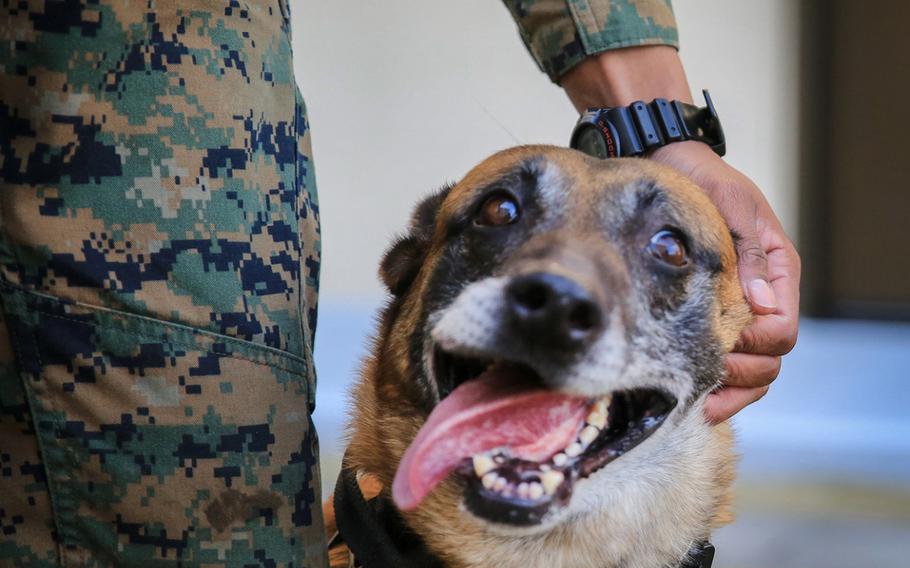
Azra, a military working dog aboard Marine Corps Air Station Iwakuni, Japan, on Feb. 6, 2014, is described by her handler, Lance Cpl. DeSean R. White, as, "that goofy person in office," but also who always gets their work done and does it well. White said, no matter how he is feeling, when he is around Azra, her personality brightens his day. (D. A. Walters/United States Marines Corps)
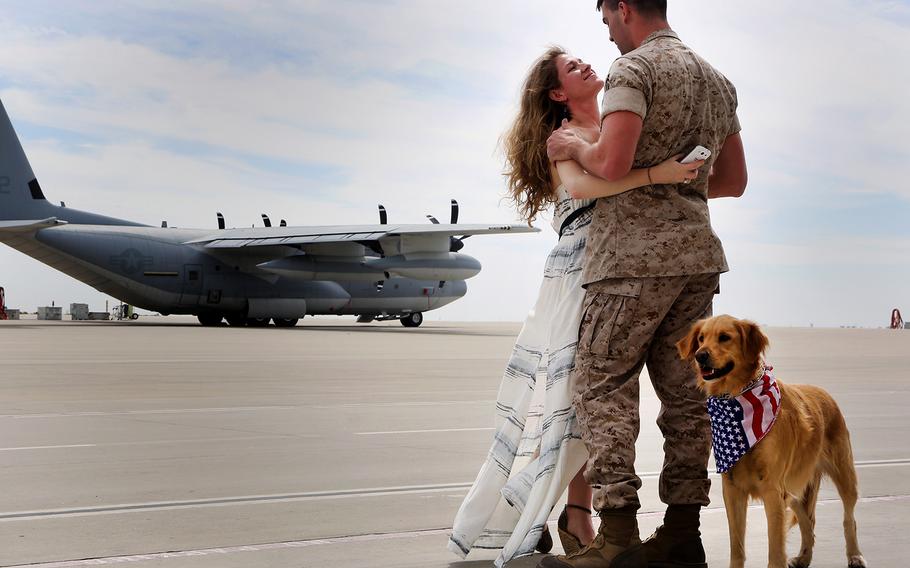
Angelica Dillender, and their dog Bella at Marine Corps Air Station Miramar, San Diego, Calif., March 20, 2014. Dillender was deployed in support of Operation Enduring Freedom. (Keonaona C. Paulo/United States Marines Corps)
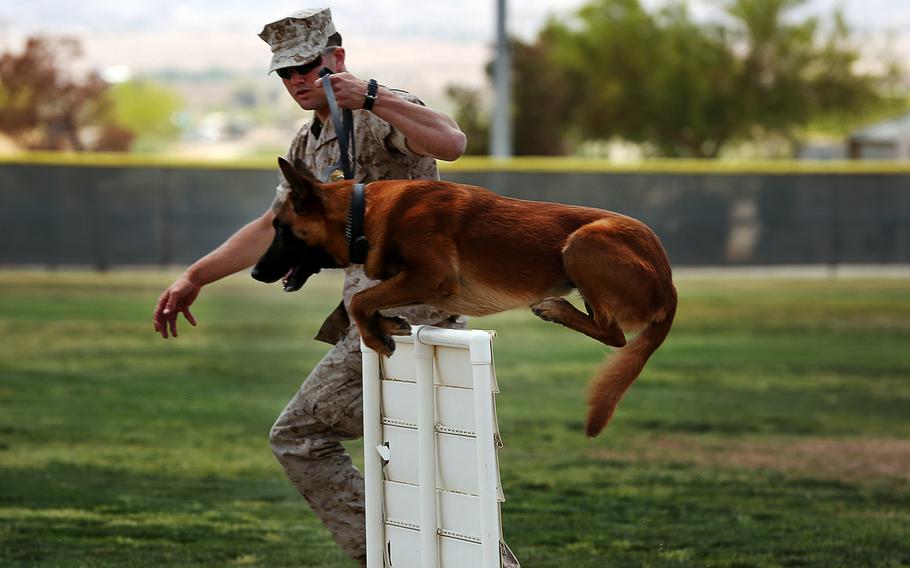
Marines with the Provost Marshal's Office conduct a K-9 demonstration for Oasis Elementary School 6th-grade students at Felix Field on May 7, 2014. More than 60 students were in awe at the demonstration of the dogs discipline and ferocity. (Ali Azimi/United States Marine Corps)
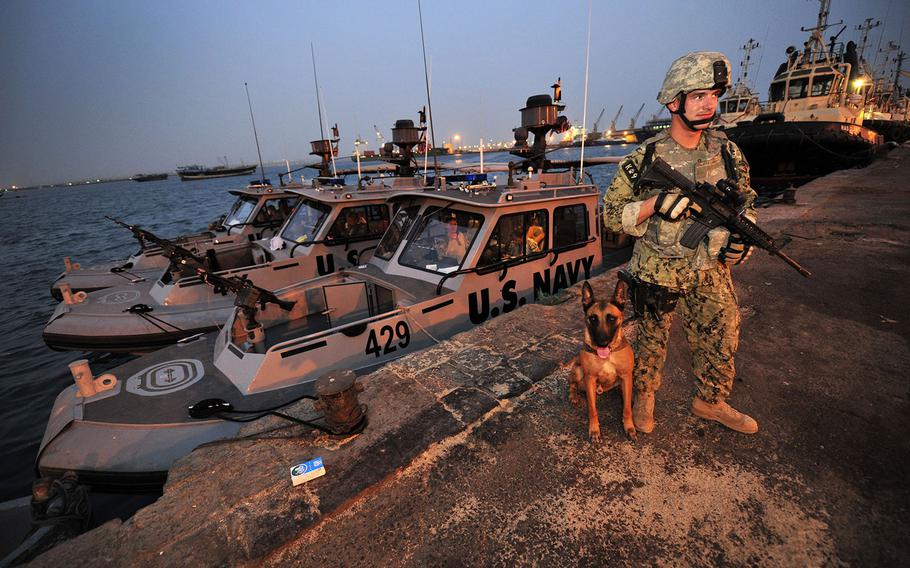
Master-at-Arms 2nd Class John Winjum, a military working dog handler, assigned to Camp Lemonnier, Djibouti security forces, stands duty at the Port of Djibouti during an inspection of ships, tugboats and the pier on July 7, 2014. (Julia A. Casper/U.S. Navy)
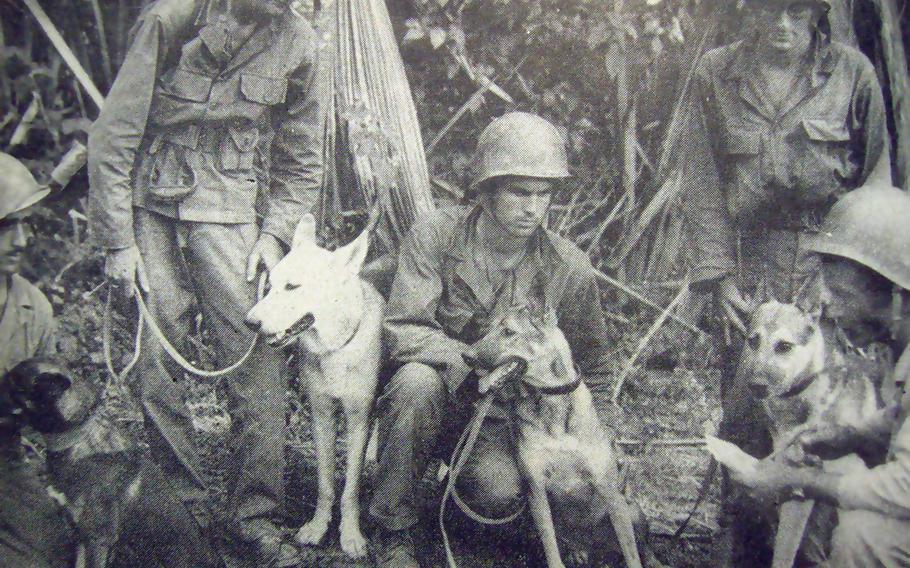
One of the first scout dog patrols to be used on Luzon in WWII. This was a briefing prior to a patrol. (Courtesy of the United States Army)
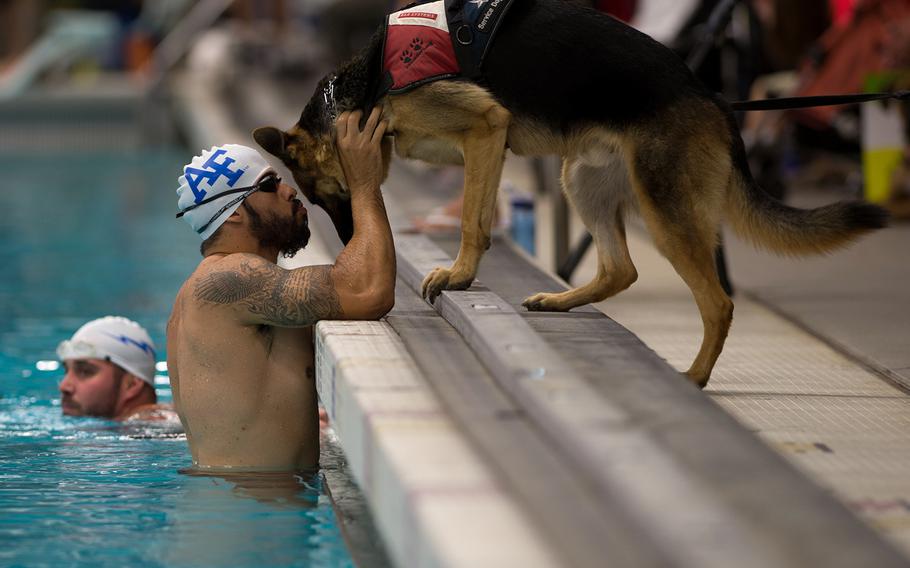
Air Force athlete August O'Niell kisses his service dog, Kai, during warmups for the swimming portion of the 2014 Warrior Games Sept. 30, 2014, at the U.S. Olympic Training Center in Colorado Springs, Colo. The Warrior Games consist of athletes from the Defense Department, who compete in Paralympic-style events for their respective military branch. (Justyn M. Freeman/U.S. Air Force)
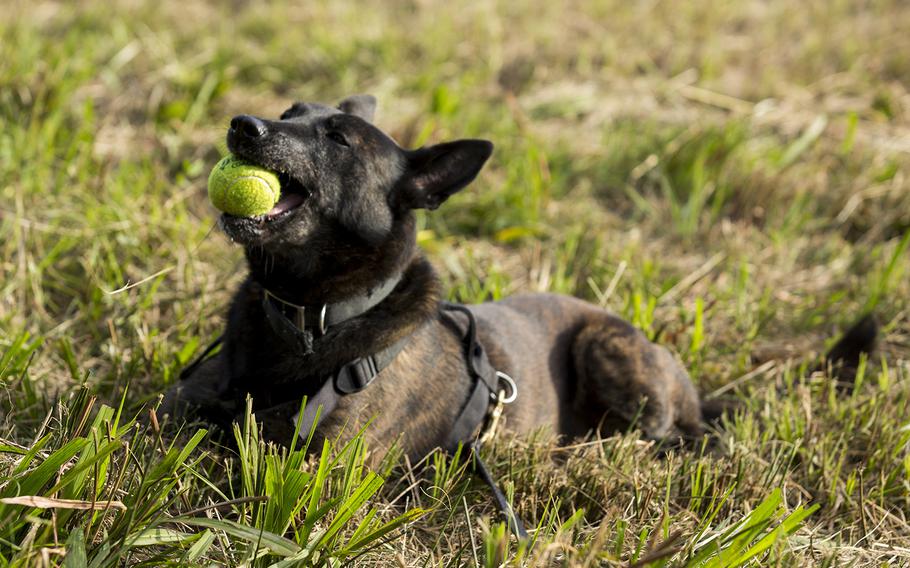
Nicky, a military working dog with Military Working Dog Platoon, 2nd Law Enforcement Battalion, II Marine Expeditionary Force Headquarters Group, chews on a tennis ball after tracking the scent of a Marine aboard Marine Corps Base Camp Lejeune, N.C., Oct. 9, 2014. Seven Marines and five canines conducted bite, tracker and patrol training, enhancing the dogs' sense of hearing and smelling. ( Lucas J. Hopkins/United States Marines Corps)
Lance Cpl. Jacob Varela, a combat tracker with Military Working Dog Platoon, 2nd Law Enforcement Battalion, II Marine Expeditionary Force Headquarters Group, and a Chicago, Ill., native, pets his dog Atilla after she found a hidden tennis ball aboard Marine Corps Base Camp Lejeune, N.C., Oct. 9, 2014. Atilla was able to capture the ball by tracking the scent from another Marine. (Lucas Hopkins/United States Marine Corps)
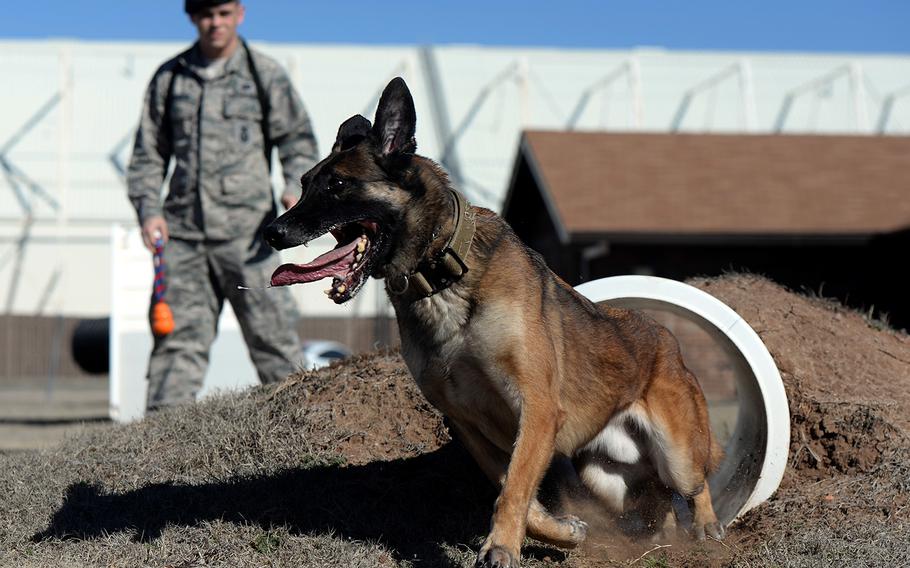
Yyoda, a U.S. Air Force military working dog, runs through a buried tunnel as part of obstacle course training with his handler, U.S. Air Force Staff Sgt. Justin Ridenour, 97th Security Forces Squadron working dog handler, at the kennels, Feb. 10, 2015. The obstacle course consists of a suspended tunnel, a buried tunnel, stairs, an A-frame, a catwalk and three hurdles. The purpose of the obstacle course is to put the canines in situations that other dogs may not normally experience. It gets them out of their comfort zone so they are more likely to chase a perpetrator, or accompany their handler through dangerous or unusual terrain. (Megan Acs/U.S. Air Force)
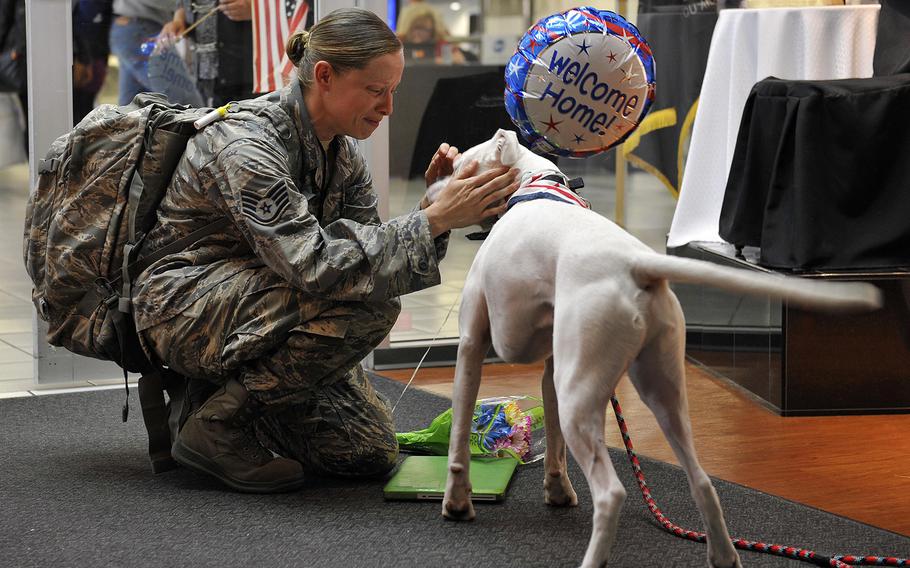
Staff Sgt. Arin Vickers, assigned to the 435 Supply Chain Operations Squadron, is greeted by her dog when she arrives at the St. Louis Airport USO, in St. Louis, May 6, 2015. Vickers was gone for six months, and her friends and family were there to greet her and surprise her by bringing along Baxter. (Erica Crossen/U.S. Air Force)
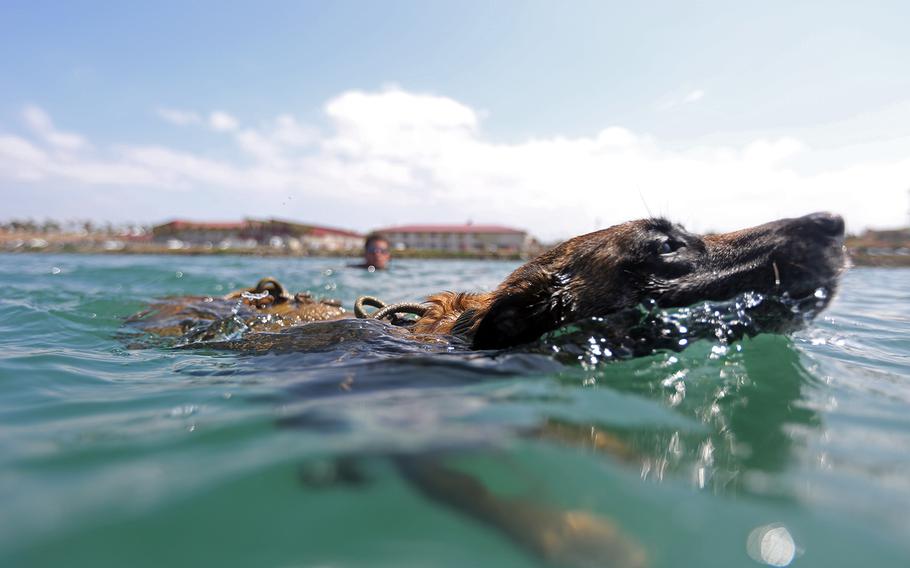
A Marine with 1st Marine Raider Support Battalion, U.S. Marine Corps Forces, Special Operations Command, and his Multi-Purpose Canine demonstrate long-distance scout swimming techniques near the Del Mar Marina aboard Marine Corps Base Camp Pendleton, Calif., May 15, 2015. (Donovan Lee/United States Marine Corps)
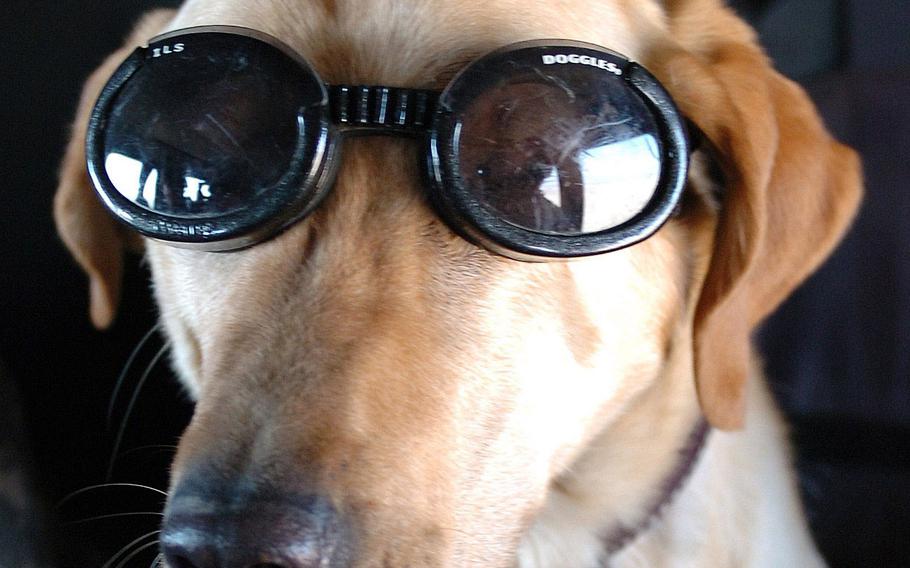
Eddie hops aboard a UH-60 Black Hawk helicopter, along with Iraqi security forces and soldiers from the 82nd Airborne Division, on Feb. 20, 2007. (Daniel Bearl/U.S. Army)
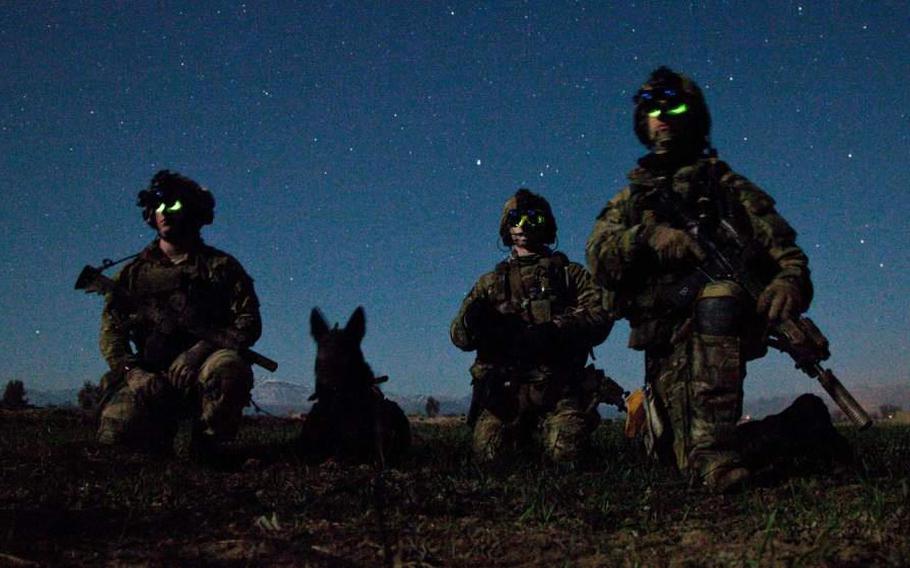
Rangers from Headquarters Company, 3rd Battalion, 75th Ranger Regiment and a multi-purpose canine pause during a nighttime combat mission in Afghanistan on March 6, 2012. (Courtesy of the U.S. Army)
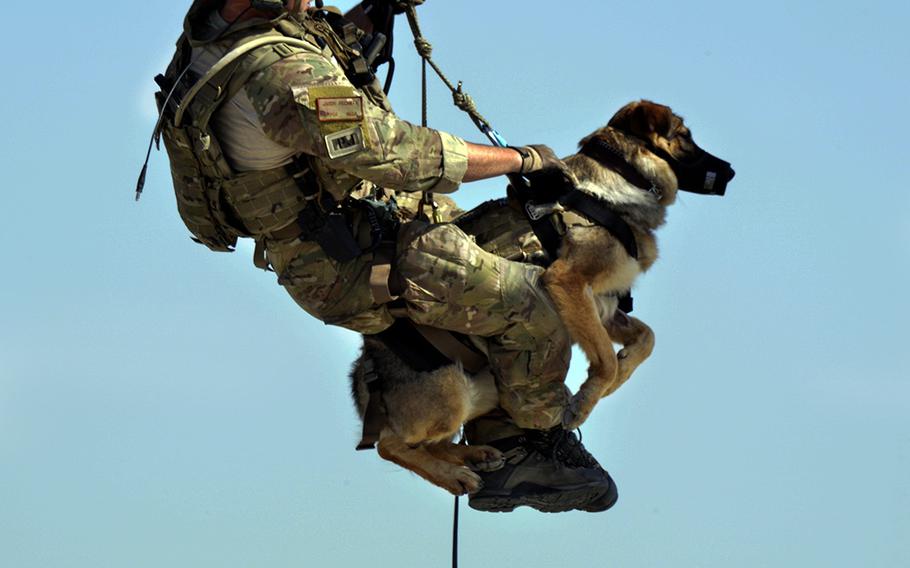
Airman 1st Class Jason Fischman hoists a U.S. Army tactical explosive detection dog into a HH-60G Pave Hawk during a joint rescue training scenario June 21, 2013, at Bagram Airfield, Afghanistan. This training was a first for both branches and prepared them for future rescue missions. (U.S. Air Force photo by Staff Sgt. Stephenie Wade) (Stephenie Wade/U.S. Air Force)
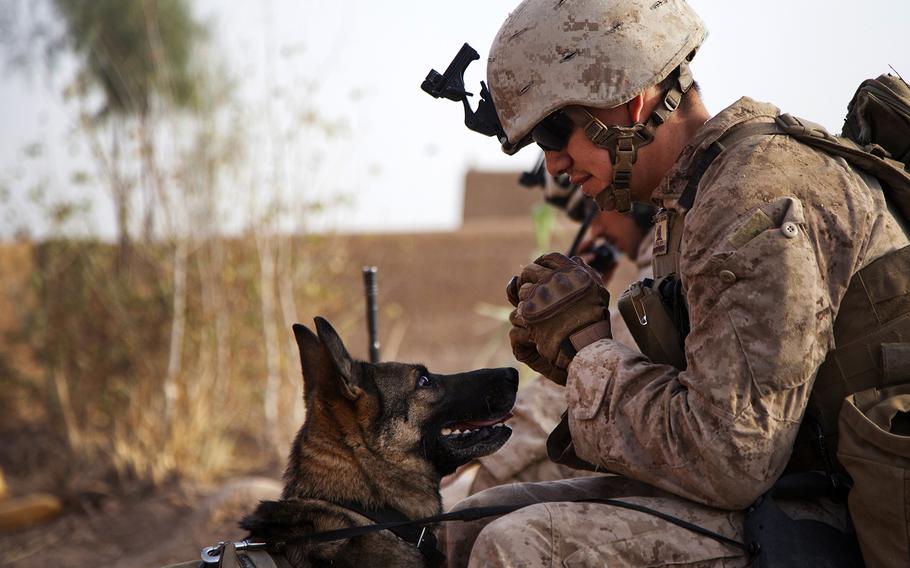
Lance Cpl. Joseph Nunez from Burbank, Calif., interacts with Viky, a U.S. Marine Corps improvised explosive device detection dog, after searching a compound while conducting counter-insurgency operations in Helmand province, Afghanistan, July 17, 2013. The Marines of Fox Company, 2nd Battalion, 2nd Marine Regiment conducted operations to deter insurgent activity, establish a presence and gather human intelligence. (Alejandro Pena/United States Marine Corps)
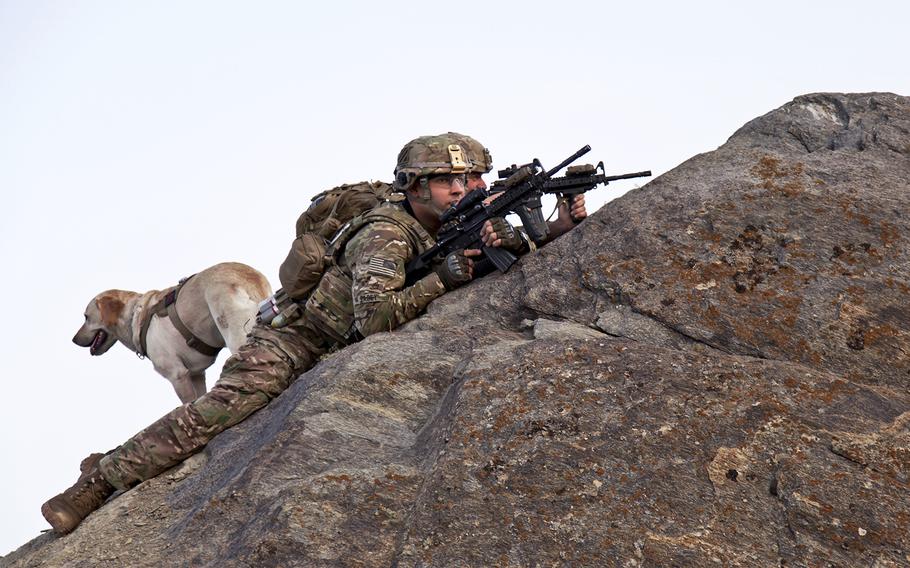
U.S. Army Staff Sgt. Sean Pabey, truck commander, Sgt. James Carlberg dog handler and his dog Staff Sgt. Abby, assigned to 1st Platoon, Apache Company, 3-15th Infantry Brigade, provide overwatch from the mountain tops of Maiden Shar, Afghanistan, Sept. 1, 2013 during operation Apache Shield. The operation allows U.S soldiers to assist the Afghan Military Police by showing a larger presence on the surrounding mountain tops to deter any enemies of Afghanistan in the area from launching indirect fire onto Forward Operating Base Airborne. (Rachel M. Copeland/U.S. Army)
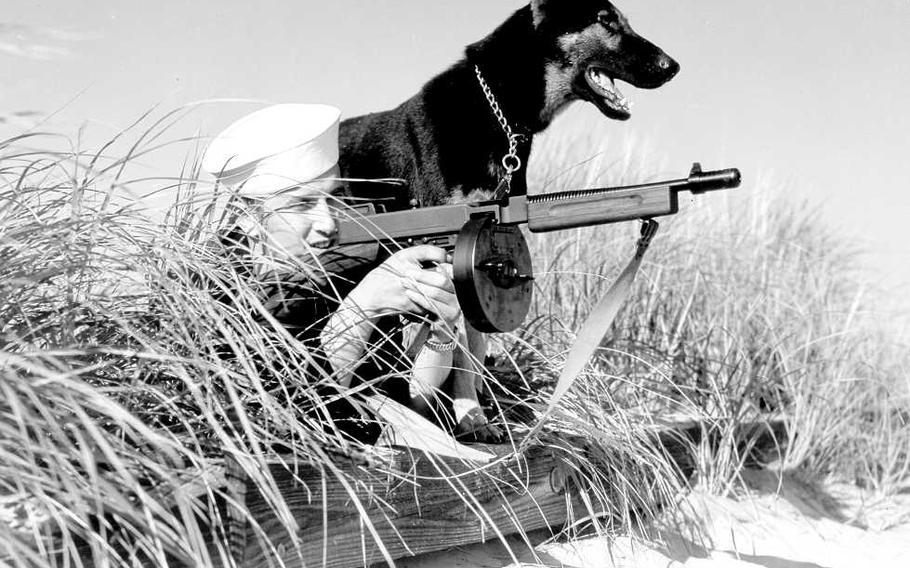
On a lonely outpost on the Atlantic, this alert, trained dog gives the signal of warning to the Coast Guardsmen who then challenges any suspected enemy spies and saboteurs. The date and photographer is unknown. (Courtesy of the U.S. Coast Guard)
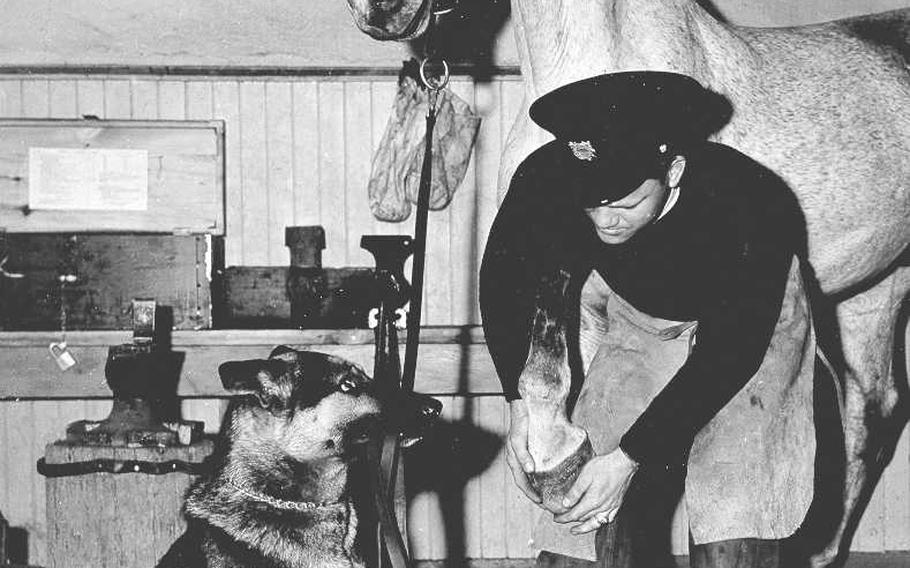
Man, dog, and horse have always been inseparable pals. U.S. Coast Guardsman Joe Opalka, a blacksmith at a horse and dog beach patrol station on the Pacific Coast, prepares to shoe an equine Coast Guard member, while a canine guardian holds fast the reins. (United States Coast Guard)
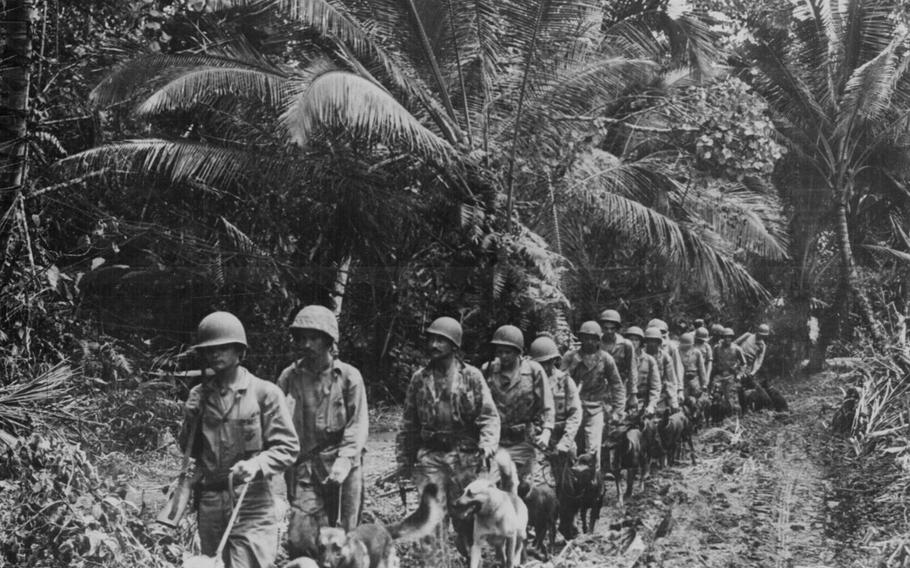
U.S. Marine Raiders and their dogs, which are used for scouting and running messages, starting off for the jungle front lines on Bougainville, sometime during November or December 1943. (T.Sgt. J. Sarno/National Archives)
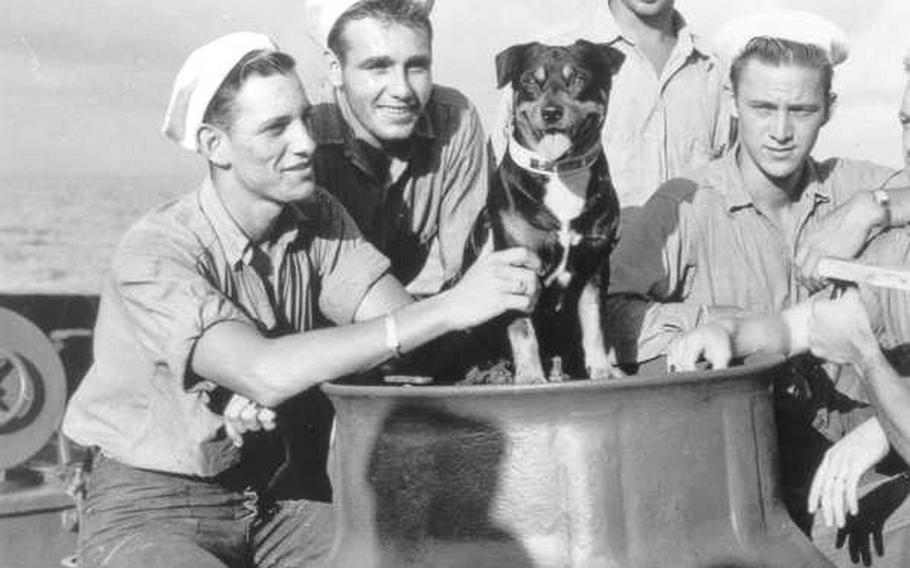
Sinbad and some of his shipmates on board the cutter Campbell in the North Atlantic, 1943. Sinbad was adopted in 1938 by the Coast Guard and quickly became world famous. According the Coast Guard: "He was, literally, a member of the crew, complete with all the necessary enlistment forms and other official paperwork, uniforms, and his own bunk. He sailed on board the combat-tested cutter through World War II and saw much action, both at sea and in port." (Courtesy of the U.S. Coast Guard)
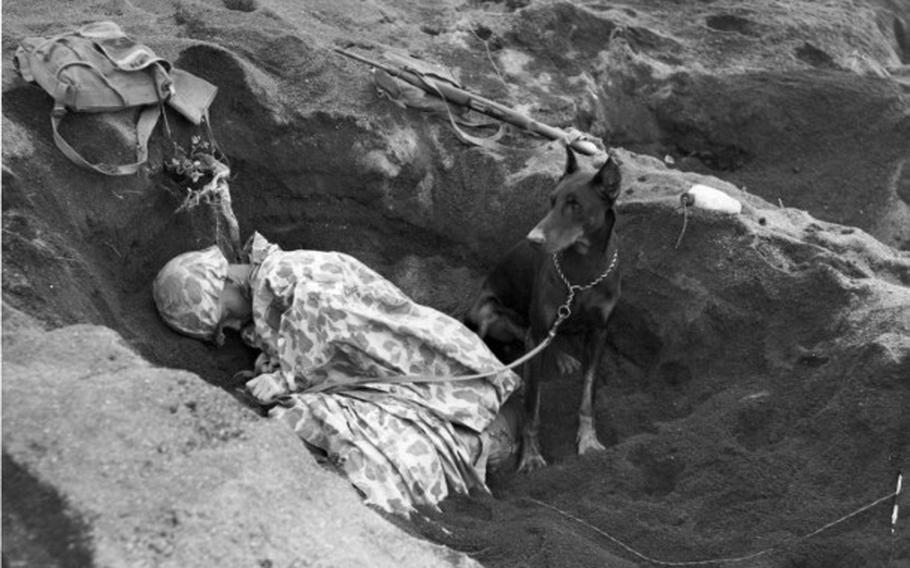
Private Rez Hester takes a nap while “Butch,” a war dog, stands guard in Iwo Jima during World War II. (Courtesy of U.S. Marine Corps)
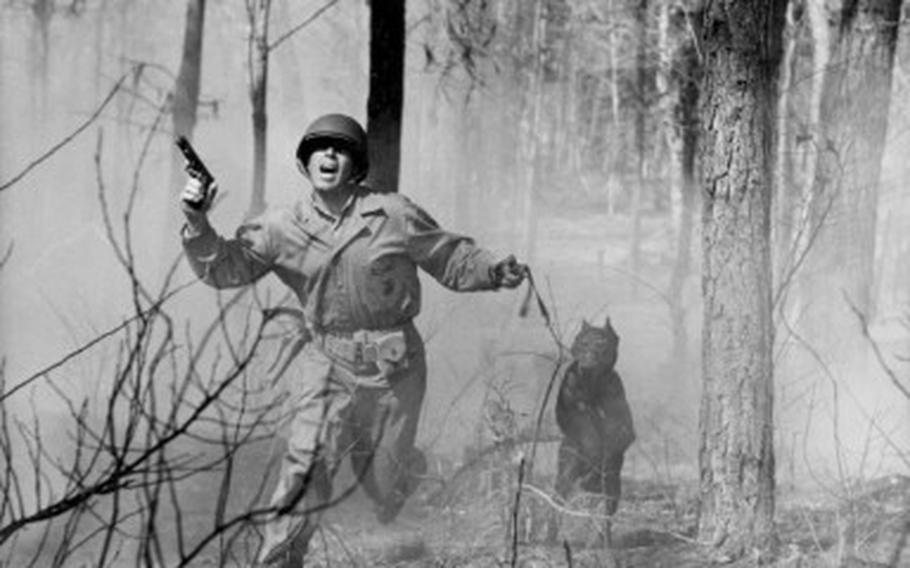
The Devil Dog Charge: Marine Pvt Michael PiPoi, of Needham, Mass., and his Devil Dog partner, charge through the smoke of battle during training at the War Dog Detachment School, Camp Lejeune, N.C., in March 1943. (Courtesy of U.S. Marine Corps)
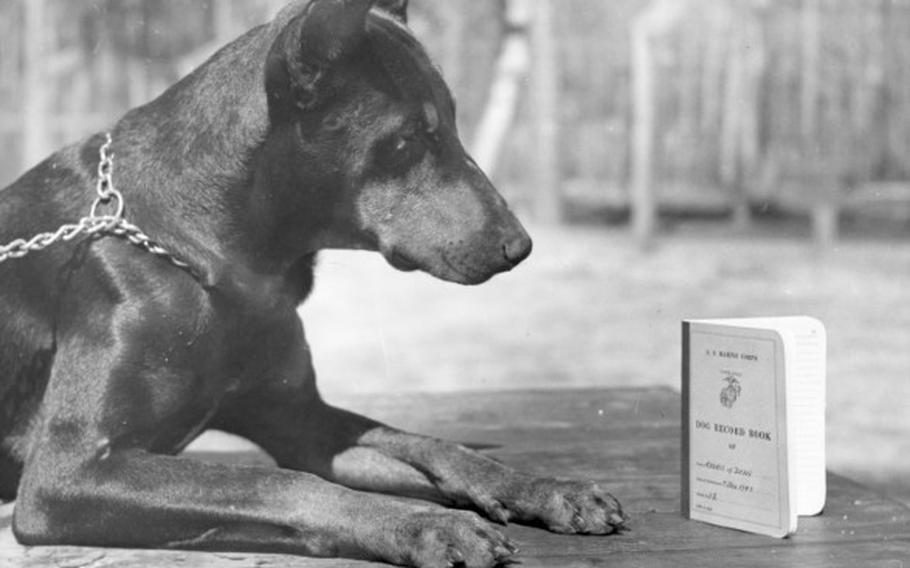
A Devil Dog in training: Marine Devil Dogs learn the art of war at canine training camp Lejeune, New River, N.C. , in 1943. These dogs are being specially trained to accompany Marines qualifications, promotions and citations – similar to his master’s, a fighting Marine. Pvt “Dean” is a Doberman Pinscher, who was enlisted by his owner for the duration of World War II. (Courtesy of the United States Marine Corps)
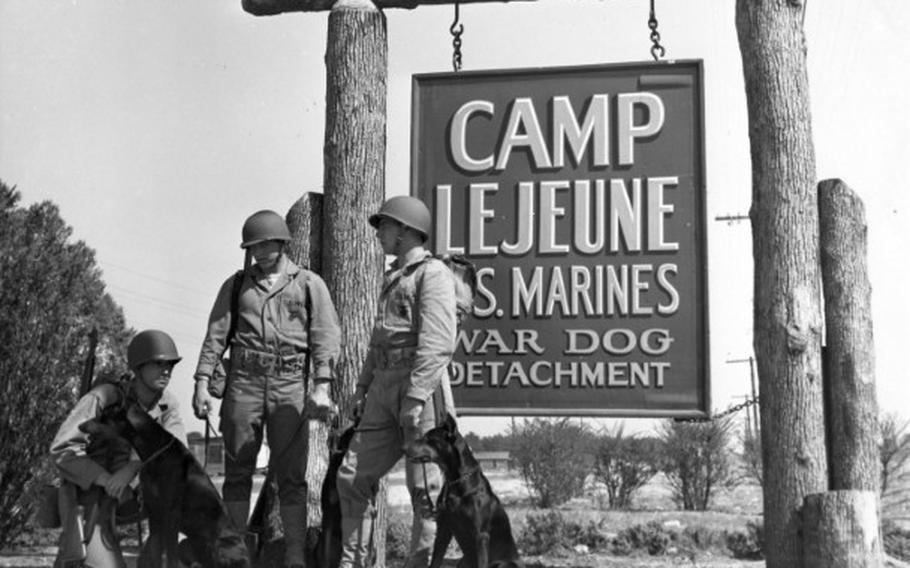
Entrance to the new kennels at Camp Lejeune where canine Marines are put through their boot camp in March 1943. (Courtesy of the U.S. Marine Corps)
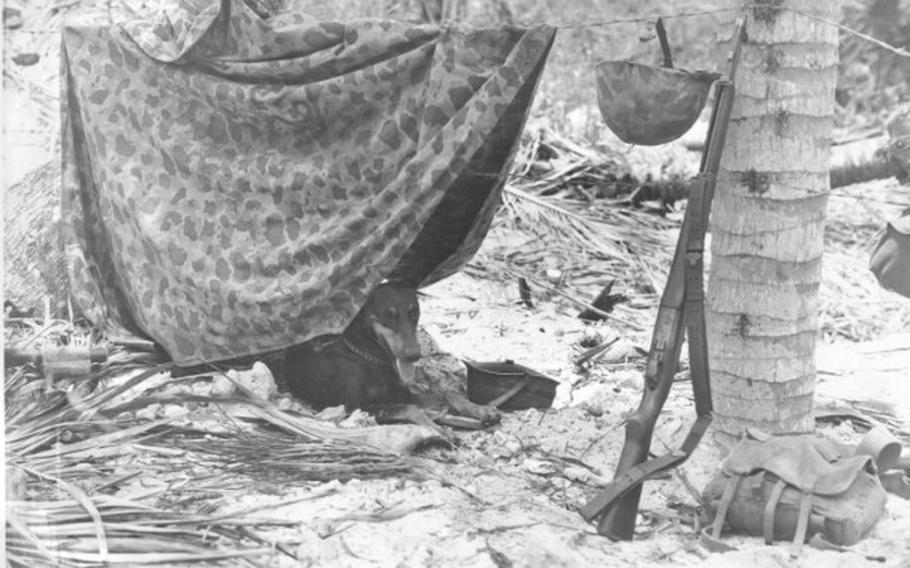
A Marine Corps War Dog rests in the shade of a camouflaged shelter-half hung over a barbed wire entanglement, after a hard tour of front line duty at Guam during World War II. The exact date is unknown. (Courtesy of the U.S. Marine Corps)
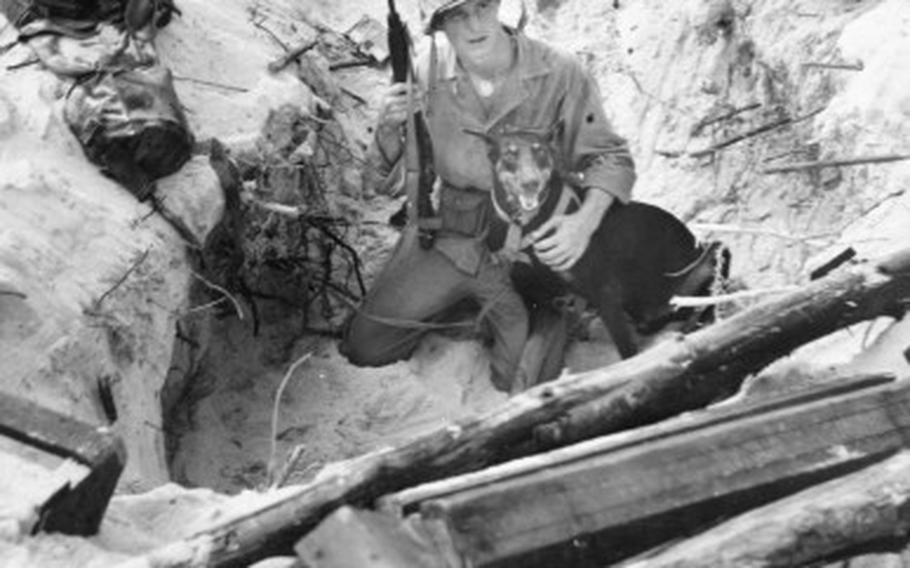
Foxhole buddies: Ready for action in their foxhole on Peleliu, are Marine Corporal William R. Scott of Greensboro, N.C., and his Doberman-Pinscher War Dog, “Prince.” (Courtesy of the United States Marine Corps)
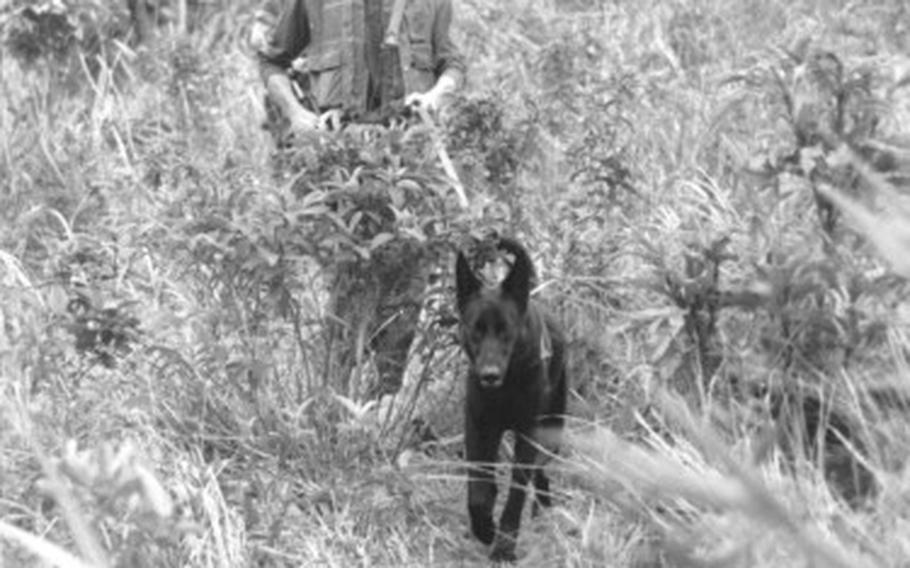
Scout dog Nick and his handler, Lance Corporal Lewis A. Raborn from War Dog Platoon, 1st military Police Battalion, Force Logistic Command, take the point of a patrol in the Khe Sahn Mountains during the Vietnam War. The exact date is unknown. (R. D. Lucas/United States Marine Corps)
Whether battle-trained or just loyal, man's best friend has been photographed following troops into battle since the Civil War. And just like the changes in tactics through the years, the relationship between servicemembers and canine companions has evolved through training, on the battlefield, and how they're used back home.
With wagging tales and slobbering kisses, dogs now help assimilate servicemembers to life away after returning home — something Stars and Stripes has documentedseveral times in the twilight of the United States' most recent conflicts.
In celebration of National Dog Day, here's a look back at the dogs that have greeted, helped and stayed by their best friends during the most trying times.
Sign up to receive a daily email of today's top military news stories from Stars and Stripes and top news outlets from around the world.
